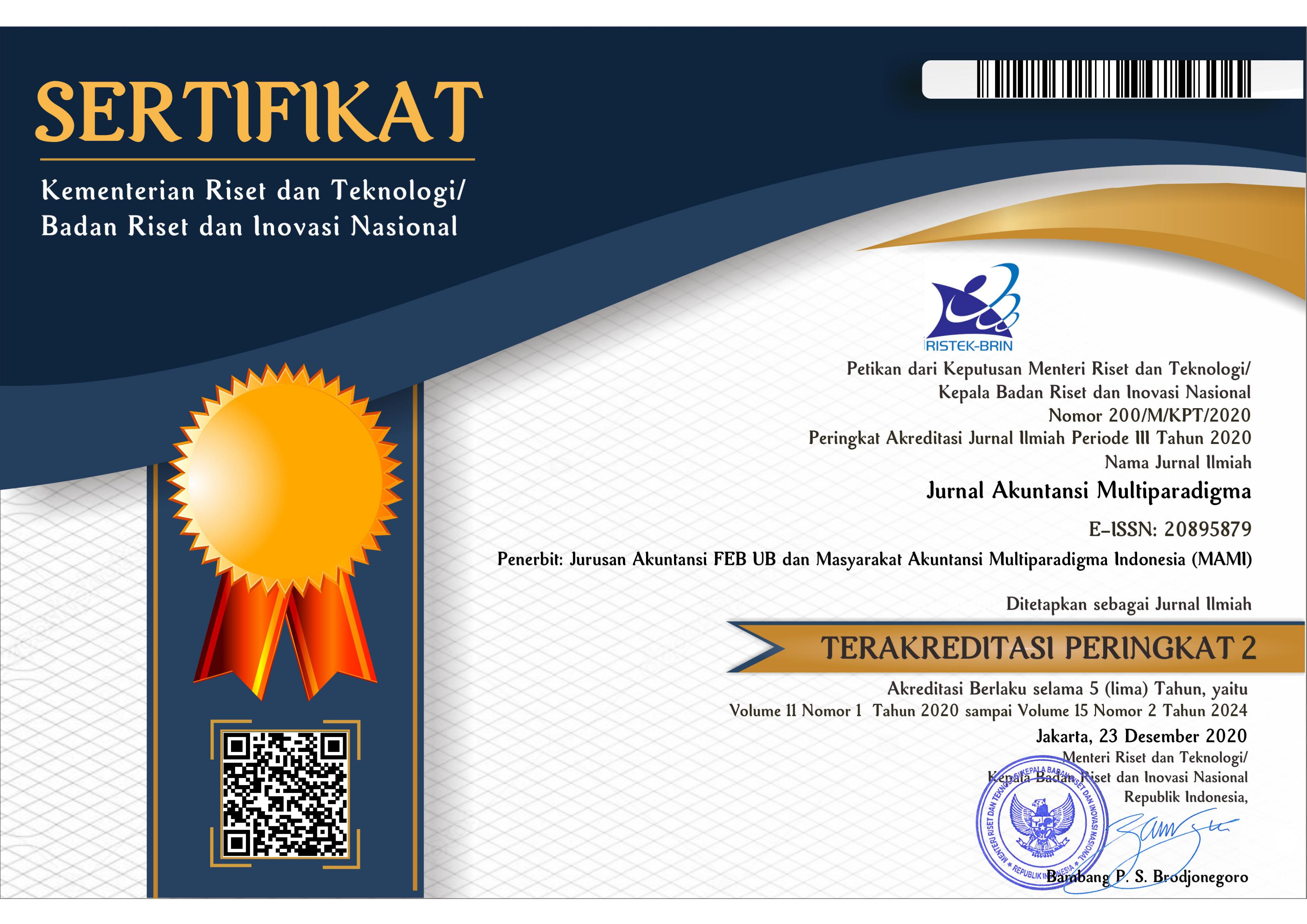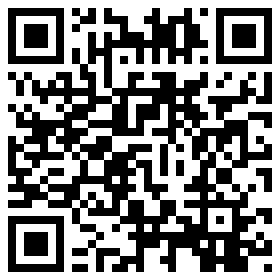MENELISIK LIKA-LIKU MODUS MANIPULASI KREDIT DALAM PERBANKAN
Abstract
Abstrak - Menelisik Lika-Liku Modus Manipulasi Kredit dalam Perbankan
Tujuan Utama - Penelitian ini berupaya menelaah modus kecurangan pemberian kredit perbankan melalui efektivitas peran audit internal.
Metode – Penelitian ini menggunakan studi kasus sebagai metode untuk mendeskripsikan pola-pola kecurangan kredit. Sejumlah pihak yang terlibat dalam operasional perbankan menjadi informan pada penelitian ini.
Temuan Utama - Modus kecurangan seperti kredit fiktif, pelunasan kredit yang tidak dilunaskan, dan mark-up pemberian kredit menjadi temuan auditor. Pelaku memanfaatkan kesempatan memanipulasi dokumen kredit debitur. Selain itu, pelaku juga mark up plafon pemberian kredit dan pembayaran cicilan kredit yang tidak dilunaskan.
Implikasi Teori dan Kebijakan – Audit internal perlu dilakukan untuk meminimalisit modus kecurangan. Selain itu, rotasi karyawan sangat diperlukan sesuai rekomendasi auditor internal.
Kebaruan Penelitian – Investigasi atas modus manipulasi kredit menjadi kebaruan dalam penelitian ini, khususnya dalam bidang kecurangan akuntansi.
Abstract - Examining the Twists and Turns of Credit Manipulation Mode in Banking
Main Purpose - This study seeks to examine the fraudulent lending model in banking through the effectiveness of the role of internal audit.
Method – This study uses a case study as a method to describe patterns of credit fraud. Some parties involved in banking operations became informants in this study.
Main Findings - Fraud modes such as fictitious credit, unpaid credit repayments, and credit mark-ups were found by the auditors. Perpetrators take advantage of the opportunity to manipulate debtor credit documents. In addition, the perpetrators also mark up the credit limit and payment of unpaid credit installments.
Theory and Practical Implications – Internal audits need to be carried out to minimize fraud modes. In addition, employee rotation is essential according to the recommendations of the internal auditors.
Novelty – Investigation of credit manipulation mode is a novelty in this study, particularly in the field of accounting fraud.
Keywords
Full Text:
PDFReferences
Adesina, K., Erin, O., Ajetunmobi, O., Ilogho, S., & Asiriuwa, O. (2020). Does Forensic Audit Influence Fraud Control? Evidence from Nigerian Deposit Money Banks. Banks and Bank Systems, 15(2), 214-229. https://doi.org/10.21511/bbs.15(2).2020.19
Albizri, A., Appelbaum, D., & Rizzotto, N. (2019). Evaluation of Financial Statements Fraud Detection Research: A Multi-Disciplinary Analysis. International Journal of Disclosure and Governance, 16(4), 206-241. https://doi.org/10.1057/s41310-019-00067-9
Albrecht, A., Mauldin, E. G., & Newton, N. J. (2018). Do Auditors Recognize the Potential Dark Side of Executives' Accounting Competence? The Accounting Review, 93(6), 1-28. https://doi..org/10.2308/accr-52028
Anisah, H. N., & Falikhatun. (2021). Realitas Pengawasan di Tubuh Pemerintahan Desa terhadap Korupsi. Jurnal Akuntansi Multiparadigma, 12(1), 153-172. https://doi.org/10.21776/ub.jamal.2021.12.1.09
Arnold, D. F., Dorminey, J. W., Neidermeyer, A. A., & Neidermeyer, P. E. (2013). Internal and External Auditor Ethical Decision-Making. Managerial Auditing Journal, 28(4), 300–322. https://doi.org/10.1108/02686901311311918
Awang, Y., & Ismail, S. (2018).Determinants of Financial Reporting Fraud Intention among Accounting Practitioners in the Banking Sector: Malaysian Evidence. International Journal of Ethics and Systems, 34(1), 32-54. https://doi.org/10.1108/IJOES-05-2017-0080
Azis, N. A., Mangoting, Y., & Lutfillah, N. Q. (2015). Memaknai Independensi Auditor dengan Keindahan Nilai-Nilai Kearifan Lokal Siri’ Na Pacce. Jurnal Akuntansi Multiparadigma, 6(1), 145–156. https://doi.org/10.18202/jamal.2015.04.6012
Bao, Y., Ke, B., Li, B., Yu, Y. J., & Zhang, J. (2020). Detecting Accounting Fraud in Publicly Traded U.S. Firms Using a Machine Learning Approach. Journal of Accounting Research, 58(1), 199-235. https://doi.org/10.1111/1475-679X.12292
Boyle, D. M., Dezoort, F. T., & Hermanson, D. R. (2015). The Effect of Alternative Fraud Model Use on Auditors’ Fraud Risk Judgments. Journal of Accounting and Public Policy, 34(6), 578-596. https://doi.org/10.1016/j.jaccpubpol.2015.05.006
Chambers, A. D., & Odar, M. (2015). A New Vision for Internal Audit. Managerial Auditing Journal, 30(1), 34–55. https://doi.org/10.1108/MAJ-08-2014-1073
Chen, Y., Wu, C., Chen, Y., Li, H., & Chen, H. (2017). Enhancement of Fraud Detection for Narratives in Annual Reports. International Journal of Accounting Information Systems, 26, 32-45. https://doi.org/10.1016/j.accinf.2017.06.004
Cristina, T., Marian, S., Veronica, G., & Dan-Andrei, C. (2021). Fiscal and Accounting Fraud Risk Detection Using Beneish Model. A Romanian Case Study. International Journal of Business and Society, 22(1), 296-312. https://doi.org/10.33736/IJBS.3176.2021
Dong, W., Liao, S., & Zhang, Z. (2018). Leveraging Financial Social Media Data for Corporate Fraud Detection. Journal of Management Information Systems, 35(2), 461-487. https://doi.org/10.1080/07421222.2018.1451954
Dorminey, J., Fleming, A. S., Kranacher, M. J., & Riley, R. A. (2012). The Evolution of Fraud Theory. Issues in Accounting Education, 27(2), 555–579. https://doi.org/10.2308/iace-50131
Eulerich, M., Henseler, J., & Köhler, A. G. (2017). The Internal Audit Dilemma – The Impact of Executive Directors versus Audit Committees on Internal Auditing Work. Managerial Auditing Journal, 32(9), 854–878. https://doi.org/10.1108/MAJ-08-2016-1435
Fang, V. W., Huang, A. H., & Wang, W. (2017). Imperfect Accounting and Reporting Bias. Journal of Accounting Research, 55(4), 919-962. https://doi.org/10.1111/1475-679X.12170
Flasher, R., & Lamboy-Ruiz, M. A. (2019). Impact of Enforcement on Healthcare Billing Fraud: Evidence from the USA. Journal of Business Ethics, 157(1), 217-229. https://doi.org/10.1007/s10551-017-3650-z
Free, C. (2015). Looking through the Fraud Triangle: A Review and Call for New Directions. Meditari Accountancy Research, 23(2), 175-196. https://doi.org/10.1108/MEDAR-02-2015-0009
Goffin, K., Åhlström, P., Bianchi, M., & Richtnér, A. (2019). Perspective: State-of-the-Art: The Quality of Case Study Research in Innovation Management. Journal of Product Innovation Management, 36(5), 586-615. https://doi.org/10.1111/jpim.12492
Hamilton, E. L., Hirsch, R. M., Rasso, J. T., & Murthy, U. S. (2019). The Effects of a Public Indicator of Accounting Aggressiveness on Managers’ Financial Reporting Decisions. Managerial Auditing Journal, 34(8), 986-1007. https://doi.org/10.1108/MAJ-07-2018-1955
Holzman, E. R., Miller, B. P., & Williams, B. M. (2021). The Local Spillover Effect of Corporate Accounting Misconduct: Evidence from City Crime Rates. Contemporary Accounting Research, 38(3), 1542-1580. https://doi.org/10.1111/1911-3846.12659
Jiang, L., André, P., & Richard, C. (2018). An International Study of Internal Audit Function Quality. Accounting and Business Research, 48(3), 264–298. https://doi.org/10.1080/00014788.2017.1357461
Joseph, C., Utami, I., Madi, N., Rahmat, M., Janang, J. T., & Omar, N. H. (2021). A Comparison of Online Fraud Prevention Disclosure in Malaysian and Indonesian Public Universities. Management and Accounting Review, 20(2), 59-83. https://doi.org/10.24191/MAR.V20i02-03
Kabuye, F., Nkundabanyanga, S. K., Opiso, J., & Nakabuye, Z. (2017). Internal Audit Organisational Status, Competencies, Activities and Fraud Management in the Financial Services Sector. Managerial Auditing Journal, 32(9), 924–944. https://doi.org/10.1108/MAJ-09-2016-1452
Kern, S. M., & Weber, G. J. (2016). Implementing a “Real-World” Fraud Investigation Class: The Justice for Fraud Victims Project. Issues in Accounting Education, 31(3), 255-289. https://doi.org/10.2308/iace-51287
Krichene, A., & Baklouti, E. (2020). Internal Audit Quality: Perceptions of Tunisian Internal Auditors an Explanatory Research. Journal of Financial Reporting and Accounting, 19(1), 28-54. https://doi.org/10.1108/JFRA-01-2020-0010
Lehmann, C. M., & Heagy, C. D. (2017). A Case Study of Fraud Concerns at a Homeowners’ Association. Issues in Accounting Education, 32(1), 67-77. https://doi.org/10.2308/iace-51324
Lin, S., Pizzini, M., Vargus, M., & Bardhan, I. R. (2011). The Role of the Internal Audit Function in the Disclosure of Material Weaknesses. The Accounting Review, 86(1), 287–323. https://doi.org/10.2308/accr.00000016
Lisic, L. L., Silveri, S. D., Song, Y., & Wang, K. (2015). Accounting Fraud, Auditing, and the Role of Government Sanctions in China. Journal of Business Research, 68(6), 1186-1195. https://doi.org/10.1016/j.jbusres.2014.11.013
Mactavish, C., McCracken, S., & Schmidt, R. N. (2018). External Auditors’ Judgment and Decision Making: An Audit Process Task Analysis. Accounting Perspectives, 17(3), 387–426. https://doi.org/10.1111/1911-3838.12182
Marshall, L. L., & Cali, J. (2015). They Protect Us from Computer Fraud: Who Protects Us from Them? SafeNet, Inc.: A Case of Fraudulent Financial Reporting. Issues in Accounting Education, 30(4), 353-372. https://doi.org/10.2308/iace-51120
Massaro, M., Dumay, J., & Bagnoli, C. (2019). Transparency and the Rhetorical Use of Citations to Robert Yin in Case Study Research. Meditari Accountancy Research, 27(1), 44-71. https://doi.org/10.1108/MEDAR-08-2017-0202
Mihret, D. G., & Grant, B. (2017). The Role of Internal Auditing in Corporate Governance: A Foucauldian Analysis. Accounting, Auditing and Accountability Journal, 30(3), 699–719. https://doi.org/10.1108/AAAJ-10-2012-1134
Ocak, M., & Özden, E. A. (2018). Signing Auditor-Specific Characteristics and Audit Report Lag: A Research from Turkey. Journal of Applied Business Research, 34(2), 277-294. https://doi.org/10.19030/jabr.v34i2.10129
Oyerogba, E. O. (2021). Forensic Auditing Mechanism and Fraud Detection: The Case of Nigerian Public Sector. Journal of Accounting in Emerging Economies, 11(5), 752-775. https://doi.org/10.1108/JAEE-04-2020-0072
Petraşcu, D., & Tieanu, A. (2014). The Role of Internal Audit in Fraud Prevention and Detection. Procedia Economics and Finance, 16, 489–497. https://doi.org/10.1016/s2212-5671(14)00829-6
Ridder, H. (2017). The Theory Contribution of Case Study Research Designs. Business Research, 10(2), 281-305. https://doi.org/10.1007/s40685-017-0045-z
Roussy, M. (2013). Internal Auditors’ Roles: From Watchdogs to Helpers and Protectors of the Top Manager. Critical Perspectives on Accounting, 24(7–8), 550–571. https://doi.org/10.1016/j.cpa.2013.08.004
Sanusi, Z. M., Rameli, M. N. F., & Isa, Y. M. (2015). Fraud Schemes in the Banking Institutions: Prevention Measures to Avoid Severe Financial Loss. Procedia Economics and Finance, 28, 107–113. https://doi.org/10.1016/s2212-5671(15)01088-6
Schuchter, A., & Levi, M. (2015). Beyond the Fraud Triangle : Swiss and Austrian Elite Fraudsters. Accounting Forum, 39(3), 176-187. https://doi.org/10.1016/j.accfor.2014.12.001
Serrano-Cinca, C., Gutiérrez-Nieto, B., & Bernate-Valbuena, M. (2019). The Use of Accounting Anomalies Indicators to Predict Business Failure. European Management Journal, 37(3), 353-375. https://doi.org/10.1016/j.emj.2018.10.006
Setyawati, D., & Bernawati, Y. (2020). Internal Audit Function sebagai Penyedia “Kenyamanan” Komite Audit. Jurnal Akuntansi Multiparadigma, 11(3), 665-682. https://doi.org/10.21776/ub.jamal.2020.11.3.38
Soh, D. S. B., & Martinov-Bennie, N. (2011). The Internal Audit Function: Perceptions of Internal Audit Roles, Effectiveness and Evaluation. Managerial Auditing Journal, 26(7), 605–622. https://doi.org/10.1108/02686901111151332
Sood, P., & Bhushan, P. (2020). A Structured Review and Theme Analysis of Financial Frauds in the Banking Industry. Asian Journal of Business Ethics, 9(2), 305-321. https://doi.org/10.1007/s13520-020-00111-w
Suh, I., Sweeney, J. T., Linke, K., & Wall, J. M. (2020). Boiling the Frog Slowly: The Immersion of C-Suite Financial Executives into Fraud. Journal of Business Ethics, 162(3), 645-673. https://doi.org/10.1007/s10551-018-3982-3
Sun, L., & Ren, L. (2017). Research on the Accounting Fraud Approaches of Listed Companies in China. Global Business and Finance Review, 22(1), 1-7. https://doi.org/10.17549/gbfr.2017.22.1.1
Supriyadi, & Prasetyaningsih, N. U. (2021). The Role of Moral Reasoning on the Effects of Incentive Schemes and Working Relationships on Whistleblowing: An Audit Experimental Study. Gadjah Mada International Journal of Business, 23(3), 215-236. https://doi.org/10.22146/gamaijb.64394
Wang, Y., Ashton, J. K., & Jaafar, A. (2019). Does Mutual Fund Investment Influence Accounting Fraud? Emerging Markets Review, 38, 142-158. https://doi.org/10.1016/j.ememar.2018.12.005
Wrona, T., & Gunnesch, M. (2016). The One Who Sees More is More Right: How Theory Enhances the ‘Repertoire to Interpret’ in Qualitative Case Study Research. Journal of Business Economics, 86(7), 723-749. https://doi.org/10.1007/s11573-015-0799-8
DOI: http://dx.doi.org/10.21776/ub.jamal.2021.12.2.26
Refbacks
Copyright (c) 2021 Anang Suwitoyo, Tarjo, Alexander Anggono

This work is licensed under a Creative Commons Attribution-NonCommercial 4.0 International License.

















